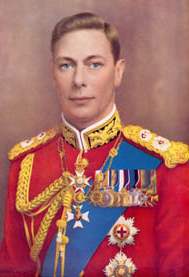Because of the distance between them and the throne, Albert and his wife were able to bring up their two daughters, Elizabeth and Margaret, in a relatively normal environment, without the pomp and circumstance that might otherwise have surrounded them. Albert was a shy man, who suffered throughout his life from a severe stammer. He was dismayed when his elder brother David, having acceded to the throne in 1936 as King Edward VIII, decided to abdicate, leaving him to take on the crown. Upon ascending to the throne, he took the name George VI, partly to comply with Queen Victoria's wish that no king of England have the name "Albert" and partly to restore confidence in the monarchy by using the same name as his father.
A few years later, World War II broke out, and the royal family, whose popularity had been waning, sought to set an example and were a decisive factor in keeping up the nation's spirits. The king's morale-boosting Christmas broadcast to the nation, early in the war, went down in history.
After the war, the king's health deteriorated rapidly. He was suffering from lung cancer and last appeared in public at London Airport to see his daughter Elizabeth off on a tour of Africa. He died suddenly at Sandringham House on February 6, 1952, and is buried at Windsor Castle. His elder daughter succeeded him as Queen Elizabeth II.
King George VI also served as the last king of Ireland in accordance
with the provisions of the (Irish) External Relations Act, 1936, until
its repeal and the coming into force of the Republic of Ireland Act, 1948,
in April 1949. Though some questioned whether the former Act actually made
him king of Ireland, that fact was explicitly acknowledged in a debate
in the Irish Senate in December 1948 by then Taoiseach (Irish Prime Minister)
John A. Costello, himself a former Irish Attorney-General. It was also
accepted by then Irish President, Sean T. O'Kelly. Current Irish president
Mary McAleese attended the funeral of his widow, Queen Elizabeth, the last
Queen of Ireland, in 2002.
| Preceded by:
Edward VIII |
List of British Monarchs | Succeeded by:
Elizabeth II |
